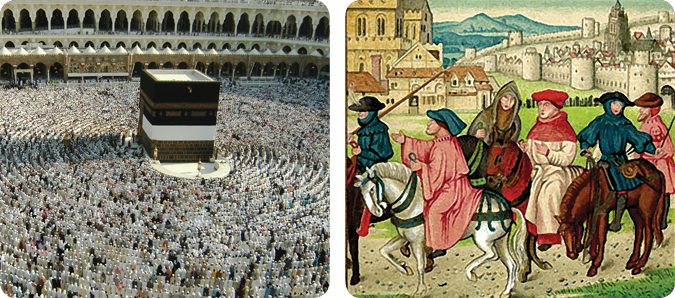
Religious and Spiritual Travel
Introduction
The relationship between human spirituality and movement is a key theme across world religions. Many religious traditions have enshrined the importance of travel in the practice of pilgrimage, missionary activity and congregational worship.
And rising very early in the morning, while it was still dark, he departed and went out to a desolate place, and there he prayed.
Mark, 1:35 [English Standard Version]
Key Aspects
Travel as Pilgrimage
Many religions have a strong concept of pilgrimage as an act of faith or spiritual discipline. In some cases this is to reach a particular destination: the Hajj to Mecca in Islam or the pilgrimages to Jerusalem in Christianity, for example. It is important to note that these journeys cannot be substituted as travel choices. In other cases, attention is drawn to the spiritual and social benefits of the journey itself.
Travel as Mission
In proselytizing religions, travel is an important consequence of missionary activity, where believers may be commanded to spread the word of their faith to new peoples and nations. In many cases, this travel has been long distance, aided by transport development, and has contributed towards the learning and discovery of new languages. On the other hand, the spread of religions competing for new converts across the globe has sometimes contributed to conflict and exploitation.
Travel for ‘Holy War’
A less pacific motivation for religious travel is the act of ‘Holy War’. Such action has been sanctioned across various faiths throughout history, often with the aim of converting non-believers or establishing religious supremacy over a territory. These wars are frequently championed by religious leaders and can offer some form of spiritual reward to those involved. For example, the medieval crusades, a series of wars sanctioned by the Roman Church in the 11th-13th centuries, were considered at the time as a form of armed pilgrimage to recover Jerusalem. Whatever the motivations for ‘Holy Wars’, as with all violent conflict they result in great human suffering and often entail the enforced travel of refugees fleeing for their lives.
Travel from Persecution
Instances of religious persecution have frequently caused religious groups to migrate long distances so that they can practice their faith freely. The journeys of persecuted Puritan sects to the Americas in the seventeenth century, or the diaspora of Jewish communities following persecution in the nineteenth and twentieth centuries, are well-known examples. As opportunities for travel have changed so these have determined patterns of settlement and survival for groups fleeing persecution.
Travel as Worship and Meditation
Many religions emphasize the importance of collective worship, the practice of which often requires regular travel. In Britain, crowds would travel to hear itinerant Methodist preachers, which contributed to the spread of the movement. In other countries, believers will walk many miles to attend their local centres of worship. Movement and travel can also be seen as part of spiritual meditation. The Parikrama in Hindu and Buddhist ritual involves meditative circumambulation around a sacred object or shrine.
Travel Restrictions
Some religious traditions place restrictions on travel. The Hindu law books ban taking voyages by sea or visiting lands beyond India, based on the belief that certain daily rituals cannot be performed while travelling. Jain monks and nuns are required to walk everywhere as the only pure means of travel, while Jewish traditions prohibit travel on the Sabbath. These restrictions can sometimes have a social or gendered dimension.
On this pilgrimage, what I have seen, and experienced, has forced me to rearrange much of my thought patterns previously held.
Malcolm X
Practical Implications
- Travel motivated by religious belief is often non-transferable: pilgrims often have to reach a particular destination.
- Access to travel for religious worship or pilgrimage is important. Transport policy does not always fit with these demands, for instance imposing parking restrictions during Friday prayers for Muslims, or poor public transport provision on Sundays for Christians.
- We should be aware that religious beliefs can also play a role in restricting people’s travel choices.
- With increasing numbers of people wanting to travel on pilgrimage, environmental impacts on the destinations and carbon emissions are growing.
‘Whan that Aprille, with his shoures soote
The droghte of March hath perced to the roote…
Thanne longen folk to goon on pilgrimages…
Chaucer, The Canterbury Tales, Prologue
Further Reading/Resources
Nicholas Shrady, Sacred Roads: Adventures from the Pilgrimage Trail (1999)
Insightful account of the experiences that arise from religious pilgrimage.
M. Craig Barnes, Searching for Home: Spirituality for Restless Souls (2003).
Exploration of the restlessness of the soul from a Christian perspective.
Michael Wolfe (ed.), One Thousand Roads to Mecca:
Ten Centuries of Travelers writing about the Muslim Pilgrimage (1998)
Fascinating tour through a compendium of writings on the Muslim Hajj.
Stephen Neill, A History of Christian Missions (1991)
Authoritative exploration of missionary travel from the Roman Empire to the present.
Key Questions
How can we better accommodate religious travel needs in transport policy?
How will religiously motivated travel change in an age of high-speed connectivity?
Can religiously motivated travel continue to increase in a world of environmental limits?

